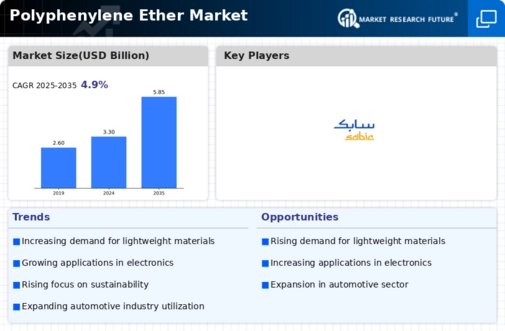Market Trends
Key Emerging Trends in the Polyphenylene Ether PPE Market
In recent years, the polyphenylene ether (PPE) market has witnessed significant growth and undergone notable shifts in market trends. Polyphenylene ether, a high-performance thermoplastic, has found widespread application across various industries due to its exceptional properties such as heat resistance, flame retardancy, and mechanical strength. One of the prominent trends driving the market is the increasing demand from the automotive sector. With a growing focus on lightweight materials to enhance fuel efficiency and reduce emissions, PPE has emerged as a preferred choice for manufacturing components in automobiles. This trend is further fueled by stringent regulations aimed at reducing greenhouse gas emissions, pushing automakers to adopt innovative materials like PPE to meet regulatory standards while maintaining performance.
The growth of the Polyphenylene Ether Market is driven by the growing use of PPE over steel in automobiles to reduce weight and enhance fuel efficiency.
Moreover, the electronics industry has also contributed significantly to the rising demand for polyphenylene ether. With the rapid advancement in technology, there is a surging need for electronic devices that can withstand higher temperatures and offer better thermal stability. PPE's excellent heat resistance and electrical properties make it an ideal choice for manufacturing electronic components such as connectors, sockets, and circuit boards. As consumer electronics continue to evolve with features like 5G connectivity and increased processing power, the demand for PPE in this sector is expected to further escalate.
Another noteworthy trend in the polyphenylene ether market is the increasing focus on sustainable and eco-friendly materials. As environmental concerns gain prominence globally, industries are actively seeking alternatives to conventional plastics that are non-biodegradable and contribute to pollution. PPE stands out as a viable solution due to its recyclability and ability to be blended with other sustainable polymers. Manufacturers are investing in research and development to enhance the recyclability of PPE and explore bio-based sources for its production, aligning with the growing demand for eco-friendly materials across various end-user industries.
Furthermore, the Asia-Pacific region has emerged as a key market for polyphenylene ether, driven by rapid industrialization, urbanization, and infrastructural development. Countries like China, India, and Japan are witnessing a surge in demand for PPE, primarily fueled by the automotive, electronics, and construction sectors. The expanding middle-class population, coupled with rising disposable incomes, has led to increased consumption of consumer goods and automobiles, thereby driving the demand for PPE-based products in the region. Additionally, favorable government initiatives and investments in infrastructure projects further propel the growth of the polyphenylene ether market in Asia-Pacific.
Despite the optimistic outlook, the polyphenylene ether market faces certain challenges that could potentially hinder its growth trajectory. Fluctuating raw material prices, primarily derived from petrochemical sources, pose a significant challenge for manufacturers in terms of cost management and profit margins. Moreover, the COVID-19 pandemic has disrupted supply chains and caused fluctuations in demand across various industries, impacting the production and consumption of PPE-based products. However, as economies recover and industries resume operations, the market is expected to regain momentum, driven by pent-up demand and ongoing technological advancements.




Leave a Comment